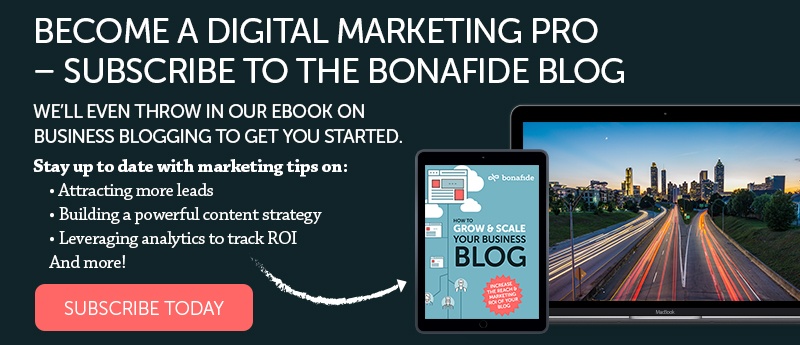
Inbound marketing is a powerful avenue for driving ROI, but let’s be honest: it can also be a seriously complex undertaking. Still, you’ve heard that more companies are investing in inbound marketing, and as a savvy leader you understand that it’s the next frontier for your business’ growth. But without the right plan, how do you ensure that inbound marketing drives ROI?
First of all, rest assured that you’re not alone. We hear these concerns from executives and marketing professionals all the time. What are the costs of marketing? And what is the cost of doing inbound yourself versus hiring an agency? These are important questions. After all, marketing should drive sales, and in order to keep investing in it, it needs to deliver revenue. Here's a set of marketing budget allocation best practices to help you navigate these complex waters and create a marketing plan that delivers inbound marketing ROI.
the costs of inbound marketing
Inbound marketing encompasses a variety of measurable digital tactics that you can integrate based on your specific business goals. Companies that recognize the proven value of inbound marketing have increased their digital marketing spend between 7 and 12% of total revenue. By knowing the purpose, cost and metrics associated with each, you can begin to carve out your inbound plan.
Here’s a breakdown of the common tactics that keen marketers are investing in:
- SEO: A solid SEO strategy helps brands' content stand out from the crowd by tapping into Google’s keyword ranking system and its ever-evolving criteria.
- PPC: Target specific consumers with paid ads—and only pay when they click. PPC shows fast results, enabling you to tap into the data to inform your SEO keyword strategies.
- Paid ads / social media: Paid ads on social media zero in on very specific attributes of your target audience, including interests, demographics, regions, and more. Pay by clicks or per impression.
- Content creation / design: Compelling content is essential for generating followers, shares, likes and visibility that drive conversions.
- PR: Combining inbound marketing and PR tactics can boost your campaign by tapping into new audiences through existing publishers.
- Website: Websites are the digital face of a business. Optimized, responsive websites are a major key to success.
- Technology tools: Technology is replete with tools you can integrate to streamline your communications and inbound tactics.
- Marketing automation: These time-saving systems help you dedicate your time to growing your business in a more hands-off way.
- CRM: Keep track of your prospects and segment them to create more targeted campaigns.
- Workers: Freelancers or in-house employees can create, optimize, and drive your inbound marketing campaign.
These are all solid ways to approach inbound marketing depending on your specific needs and audience, but they all require time or money—and sometimes, both.
Allocating your marketing budget
Budget allocation is unique to each company, and it’s largely dependent on your goals. If you have plenty of site traffic but no conversions, you’ll want to invest a greater amount into conversion channels, such as email marketing or other content with a solid call-to-action. On the other hand, if nonexistent traffic is your pain point, paid tactics like PPC or targeted social media ads can help drive traffic to your site, creating a more robust top-of-the-funnel (TOFU). Start by identifying your own business needs, goals, and pain points, which is crucial to determining the best strategy and budget allocation.
As you start out, a good rule of thumb is to allocate 40-50% of budget on planning and content creation, 20-30% on paid ads, 10% on infusing your company culture into your teams, and 10% on software and tools. From these starting points, you can revise your budget again and again as your data comes in and you revisit your strategy.
Setting SMART goals
Knowing your business goals is essential to spending your money in the smartest way. Setting SMART goals can give you the definitive edge you need to stand out from the competition and meet your digital marketing benchmarks. SMART goals enable you to lay a timeline plan for achieving your defined goals. As you create your SMART goals, here are a few things to keep in mind.
Know your channels
Social media is always evolving, and provides a meaningful avenue for making more strategic connections and tapping into new demographics and markets. Knowing where your target audience members are spending their time is essential to connecting with them in the right way. Inbound marketing is about going to the people, then drawing them back to you, all in a non-disruptive manner. Take note of what channels your competitors are using, and measure your ROI across channels to ensure you’re pouring dollars into your surest conversions.
Know your metrics
You must track your campaigns. Determine what metrics you will use to measure successes, and hawkeye them. Report your metrics regularly to ensure that you are achieving the goals you set out. If your numbers are subpar, revise your approach or strategy. This may require reallocating your marketing budget into the higher converting tactics.
How much to spend on inbound marketing
Abraham Lincoln famously said that a man should be tall enough for his feet to touch the ground. We can laugh about it, but here’s the reality: as you launch an inbound campaign, you are going to be hit with some of the biggest costs upfront. Whatever your budget, be sure to set aside a sizeable portion for these initial expenses.
Software
The right software can make or break your inbound campaign. If you’ve got an agency on board handling things, they’ll be able to show you how to use software, like HubSpot, to its fullest potential—and maximize the value of your spend.
Website
Depending on how up-to-date your website is, you may be able to hold off on major construction for a while. But if you have the budget, it’s a worthwhile endeavor to invest in it ASAP—after all, as the face of your company, your website will drive all of your inbound efforts. If it’s not optimized to convert visitors, even the best inbound campaigns can suffer.
Freelancers
Get your people in place to do what they do best. If your in-house team doesn’t have the right skillset to efficiently implement campaigns for a high ROI, then outsource. Create a running list of freelancers and their per-project rates, and those you prefer working with. Then, when you need to execute a project, refer to this list to eliminate the lag. Agencies usually have their own list of vetted freelancers who can execute excellently.
To outsource or not to outsource
As you weigh the cost savings of doing inbound yourself versus hiring an agency, consider this: bringing an expert partner into your marketing mix can help you maximize your budget by implementing tried and true marketing budget allocation best practices. By tailoring content and approaches for each channel and audience segment, they help brands connect in the ways customers care about.
Agencies regularly work with a variety of budgets and know where to put dollars to drive results. These digital pros have cross-field experience in fields like SEO, PPC, and copywriting, and regularly work with marketing managers to define and achieve goals—and build an effective campaign. Many brands save time and money by outsourcing their digital marketing to agencies with more experience and demonstrated ability in boosting ROI. After all, that new hire comes at a high price point after you factor in tools, equipment, training, and benefits.
Inbound marketing isn’t rocket science, but it can quickly feel that way when you’re faced with balancing and connecting the right mix of channels, platforms, content creation, email campaigns, paid ads, optimization—wow, that was a mouthful!
And on top of that, there’s the most important thing of all: the art of efficiently budget your marketing dollars to generate ROI.
But it doesn’t have to be an uphill battle. By understanding the inbound marketing budget best practices and setting a plan before you launch, you’ll be well on your way to driving revenue from your new digital endeavors.

